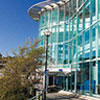
WDR is Everywhere Lately
Recommendations for getting the most out of your WDR cameras
- By Wendi Burke
- Aug 01, 2013
 The term wide dynamic
range (WDR) is used to
describe the function of a
camera designed to produce
clearer, more actionable
images and/or video in circumstances
where back light and intense
illumination can vary excessively, especially
when both very bright and very
dark areas are simultaneously present in
the camera’s field-of-view. The wider the
dynamic range, the better the camera’s
sensor can accurately capture varying
light intensities and heighten the details
visible within the area of view.
The term wide dynamic
range (WDR) is used to
describe the function of a
camera designed to produce
clearer, more actionable
images and/or video in circumstances
where back light and intense
illumination can vary excessively, especially
when both very bright and very
dark areas are simultaneously present in
the camera’s field-of-view. The wider the
dynamic range, the better the camera’s
sensor can accurately capture varying
light intensities and heighten the details
visible within the area of view.
Some examples where WDR
functionality is needed include:
- areas with rapid and constant
changes in illumination, like entryways
and exit points;
- where lighting condition in
the field-of-view moves
from a well-lit area
into a darker area;
- city transportation
centers,
such as
parking
garages,
tunnels or
train stations, where people and vehicles
enter and exit (commonly with
bright daylight outside and low levels
of light inside);
- scenarios such as toll plazas, gas stations
and anywhere vehicles with
bright headlights are driving directly
towards the camera; and
- environments with intense light reflection
off banks of windows, such as
office buildings and shopping malls,
or for areas with water features.
The challenge in attaining consistent
high-quality surveillance video is the
light cameras need to generate an image.
With too much light, the image is
blown out; too little light causes the image
to be dark and unusable. Often, a
scene has a wide range of light variation
and the camera simply can’t adjust its
iris settings or shutter speed to properly
accommodate the optimal amount of
light. However, WDR techniques have
been developed to improve the speed of
iris adjustment, and thus, enhance video
quality and integrity.
WDR Techniques
Two basic techniques are commonly used
to successfully provide WDR capability:
Multi-frame imaging. With this technique,
the camera captures multiple
frames of the field-of-view, each frame
having a different dynamic range. The
camera combines the frames to produce
one improved WDR frame.
Non-linear sensors. Typically logarithmic
sensors are the sensitivity of the sensor,
at different illumination levels varies,
enabling the capture of a wide dynamic
range image in a single frame.
Of the two techniques, multi-frame
imaging is the most commonly used by
manufacturers supporting WDR capability
for two main reasons. First, it
is superior at capturing images in realtime;
and secondly, it can process moving
objects more quickly than non-linear
sensors. Multi-frame imaging is more
cost-effective and integration-friendly,
because it is far more common in the
marketplace. While non-linear sensors
do perform well, they have not been
widely-adopted and current trends do
not suggest this technique will overtake
multi-frame imaging popularity in the
near future.
WDR Tips
When using cameras with WDR capability, there are a few things to keep in mind
during set-up and installation to ensure
the best possible output from the system.
A display note. A limiting factor
rarely considered is the display used to
view images or video.
The dynamic range that can be displayed
by normal CRT monitors is limited
to approximately 1:100. An LCD
screen is capable of even less. The approximate
1:200 signal that is generated
by the video circuits is further reduced
by the display.
To optimize a display, adjust the
contrast and brightness control of the
monitor. Setting a display with the image
at its maximum contrast will result
in sacrificing some of the dynamic
range, but this will produce a better
image. When considering a display for
surveillance use, keep in mind that the
better the contrast ration, the better the
video and images will display.
Nighttime use. WDR functionality
is not optimal for nighttime use, so
whenever possible, disable the camera’s
WDR at night in order to maximize
low-light performance if this is not an
automatic feature of the camera. WDR
cameras, using the multiple-exposure
technique, typically restrict the minimum
shutter speed, which in low-light
conditions can result in motion blur.
Because not all WDR cameras have the
option to disable this function at night,
it’s important to consider camera placement
and lighting conditions prior to
installation.
Motion blur. A common issue for
any type of camera is motion blur, occuring
when the elements in the field-ofview
being recorded change due to rapid
movement in the scene or the length of
exposure time. This is where camera
positioning and lighting considerations
play a key role in obtaining clear, usable
video images. As with any camera
set-up, the more uniform the lighting,
the better. A poorly-lit scene, requiring
longer exposure times, will create conditions
for motion blur to occur. Keep
in mind, the purpose of WDR technology
is to optimize video and images in
scenes with simultaneously very bright
and dark areas. WDR is not designed
to optimize solely low-light or extremely
bright scenes. Only use WDR cameras
where appropriate, and do not consider
them for general use.
WDR Goes Mainstream
Over the last several months, a number
of companies have introduced models
with WDR functionality or added
WDR capability to existing camera
models. Consequently, the prices of
WDR security cameras have dropped
to more affordable levels. And, because
early demand has been strong, WDR
offerings are expanding the number of
form factors to meet the needs of both
indoor and outdoor applications.
As with any security installation, the
key to success is determining the most
important goal you are trying to achieve.
If facial recognition is the crucial element,
place the camera at a height and
angle that will result in best image quality,
given the anticipated variable or fixed
lighting conditions. Capturing license
plates or other vehicle identification elements
will require different set-up and
consideration. Do your research; each
scene and camera location will be different
and may require varying functionality
to produce the most usable video and
images. There is no “one-size-fits-all”
magical technology out there that will
produce perfect video in every scenario…
at least not yet.
This article originally appeared in the August 2013 issue of Security Today.